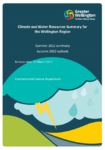Climate and Water Resources Summary for the Wellington Region - Summer 2022 summary and Autumn 2022 outlook
Search in document library
Summer 2022 was marked by very active weather systems bringing significant and widespread weather extremes in the Wellington region. We had a very wet December in the west, followed by an extreme dry January, only to be followed again by a record wet February due to the influence of ex-tropical cyclone (ex-TC) Dovi . The cyclone’s landfall was spectacular and brought record rains to the Wairarapa, with some places receiving up to eight times the normal rain for the month. Masterton had a total of 556 mm of rain for the season, making this the wettest summer on record for data available since 1926. Maximum return periods for the cyclone rainfall reveal that this was a one in 80 year event for 48 hour rainfall, and ranging between one in 40 to one in 100 year event for durations between six and 24 hours. Record warm temperatures were also observed throughout the season, both averages and extremes. In February, record high temperatures (and humidity) were measured prior to landfall of ex-TC Dovi, to be then followed by record low temperatures as the cyclone moved to the east and pushed southerly gales into the region. Highest wind gusts on record were also measured in association with the cyclone tail for both Baring Head and Mt Kaukau (up to 160 km/h). All in all, it was a remarkable season of tropical humidity, prevailing easterly flow and weather extremes.
